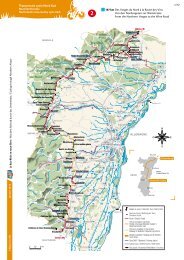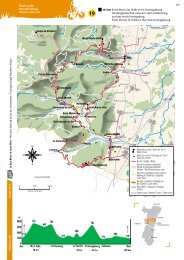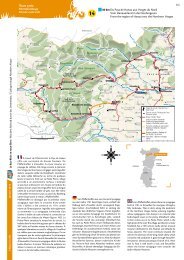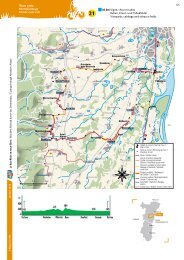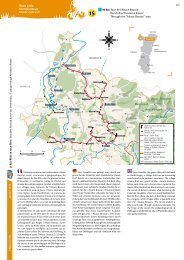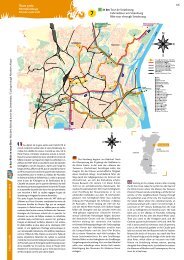94 km Les vallées des Vosges centrales Die Täler der ... - Cadr67
94 km Les vallées des Vosges centrales Die Täler der ... - Cadr67
94 km Les vallées des Vosges centrales Die Täler der ... - Cadr67
Erfolgreiche ePaper selbst erstellen
Machen Sie aus Ihren PDF Publikationen ein blätterbares Flipbook mit unserer einzigartigen Google optimierten e-Paper Software.
Janvier 2010 2008<br />
Le Bas-Rhin en roue libre / Mit dem Fahrrad durch das Unterelsass / Cycling through Northern Alsace<br />
L'Alsace à vélo<br />
Tours cyclo<br />
Fahrradrundwege<br />
Circular cycle trails<br />
1939, découvrir l’intérieur d’un fort<br />
de la Ligne Maginot, la vie sous le<br />
régime nazi, emprunter une passerelle<br />
surplombant la guerre totale,<br />
c’est l’histoire de l’Alsace-Moselle<br />
qui sera retracée avec de nombreux<br />
films et <strong>des</strong> décors plus vrais<br />
que nature. Le <strong>der</strong>nier espace est<br />
consacré à la réconciliation francoallemande<br />
et à la construction.<br />
Hoch über dem Bruchetal<br />
beginnt an <strong>der</strong> Gedenkstätte <strong>des</strong><br />
Elsass und <strong>der</strong> Moselle ein pädagogischer<br />
und interaktiver Rundgang<br />
durch die bewegte Geschichte<br />
dieser Region von 1870 bis heute.<br />
Eine Stätte ist ganz beson<strong>der</strong>s <strong>der</strong><br />
deutsch-französischen Versöhnung<br />
und dem Aufbau Europas gewidmet.<br />
Beim interaktiven Rundgang<br />
kann <strong>der</strong> Besucher in einen Waggon<br />
<strong>der</strong> Deportierten aus 1939 o<strong>der</strong><br />
in das Innere einer Festung an <strong>der</strong><br />
Maginot-Linie steigen. Gezeigt wird<br />
das Leben unter <strong>der</strong> Naziherrschaft.<br />
Es gibt auch eine Brücke über den<br />
totalen Krieg. <strong>Die</strong> Geschichte wird<br />
anhand von zahlreichen Filmen<br />
und wahrheitstreuen Nachbauten<br />
wie<strong>der</strong> lebendig. Der Rundgang<br />
endet an <strong>der</strong> Stätte <strong>der</strong> deutschfranzösischen<br />
Versöhnung und<br />
Europas Aufbau.<br />
Overlooking Bruche Valley,<br />
the Alsace-Moselle Memorial<br />
leads you on an educational,<br />
interactive trail through the<br />
ups and downs of the history of<br />
Alsace and Moselle from 1870 to<br />
present times with an area specially<br />
devoted to Franco-German<br />
reconciliation and the building of<br />
Europe. Through the interactive<br />
trail where the visitor can climb<br />
into a 1939 deportation wagon,<br />
explore the inside of a fort from<br />
the Maginot Line, discover life<br />
un<strong>der</strong> the Nazi regime and take<br />
a footbridge over outright war,<br />
the history of Alsace and Moselle<br />
is depicted through a number of<br />
films and scenes that are larger<br />
than life. The last section is devoted<br />
to Franco-German reconciliation<br />
and the building of Europe.<br />
Marché du terroir : Mercredi<br />
matin / Markt mit regionalen<br />
Produkten : Mittwoch<br />
Vormittag / Regional produce :<br />
Wednesday morning<br />
Dernier week-end de juin :<br />
Course de côte automobile<br />
Schirmeck-La Broque / Letztes<br />
Wochenende im Juni : Auto-<br />
Gebirgsrennen / Last week-end<br />
of June : Motor hillside race<br />
Musée du château de Schirmeck<br />
/ Burgmuseum von Schirmeck<br />
/ Museum of the Château of<br />
Schirmeck<br />
Côte du Château<br />
+33 (0)3 88 47 18 51<br />
tourime@hautebruche.com<br />
L'Association <strong>des</strong> Amis de la<br />
Côte du Château et du Musée<br />
de Schirmeck, ont aménagé ce<br />
musée dans l'ancien château de<br />
Schirmeck reconstruit dans les<br />
années 1970. Il présente une collection<br />
diversifiée d'objets insolites<br />
et usuels, reflets de la vie de la<br />
cité au siècle <strong>der</strong>nier. Il conserve<br />
en outre, divers témoignages du<br />
camp de Schirmeck-Vorbrück.<br />
Chaque été, une exposition à<br />
thème agrémente ce musée. Point<br />
de vue sur les villes de Schirmeck<br />
et La Broque, ainsi que sur le<br />
Massif du Donon. Accès à pied<br />
depuis l'Office de Tourisme (environ<br />
20 mn).<br />
Der Verband "Amis de la<br />
Côte du Château et du Musée<br />
de Schirmeck" hat das Museum<br />
im 1970 neu erbauten Schloß<br />
von Schirmeck eingerichtet. <strong>Die</strong><br />
Sammlung besteht aus ungewöhnlichen<br />
und alltäglichen<br />
Gegenständen aus dem Leben<br />
<strong>der</strong> Stadt im letzten Jahrhun<strong>der</strong>t.<br />
Zu sehen sind auch Zeugnisse aus<br />
dem Lager Schirmeck-Vorbrück.<br />
Jeden Sommer eine neue thematische<br />
Ausstellung. Aussicht auf<br />
Schirmeck, La Broque und die<br />
Bergkette <strong>des</strong> Donon. Anweg zu<br />
Fuß ab dem Verkehrsamt (zirka 20<br />
Minuten).<br />
The Schirmeck museum and<br />
Chateau association has set up the<br />
museum in the former Schirmeck<br />
Chateau which was reconstructed<br />
in the 1970s. It offers a varied collection<br />
of ordinary and unusual<br />
artefacts which mirror life in the<br />
town walls during the last century.<br />
It also houses vestiges from the<br />
Schirmeck-Vorbrück work camp.<br />
Each summer, an exhibition on<br />
a specific theme adds a pleasant<br />
touch to the museum. Panoramic<br />
view of the towns of Schirmeck<br />
and La Broque, and the Donon<br />
mountain. Accessible on foot<br />
from the Tourist Office (about<br />
20 min.).<br />
russ<br />
Week-end après le 14 juillet<br />
(année impaire) : Fête de le<br />
Totsche (galette de pommes<br />
de terre)<br />
Wochenende nach dem 14. Juli<br />
(ungera<strong>des</strong> Jahr) : Totsche Fest<br />
(Kartoffelpuffer)<br />
Week-end after the 14th ■<br />
of July<br />
(uneven year) : Totsche Festival<br />
(potato pancakes)<br />
■ MuTzig<br />
Fort de Mutzig (Fort "Kaiser<br />
Wilhelm II") / Feste "Kaiser<br />
Wilhelm II"/ Fortress "Kaiser<br />
Wilhelm II"<br />
+33 (0)6 08 84 17 42<br />
www.fort-mutzig.eu<br />
Construit de 1893 à 1918 sur<br />
ordre de Guillaume II, empereur<br />
d’Allemagne, ce fort d’arrêt devait<br />
empêcher une offensive française<br />
en provenance du sud de l’Alsace.<br />
Avec une superficie de 254 hectares,<br />
une puissance de feu de 6,5<br />
tonnes de munitions à la minute,<br />
ce groupe fortifié était, à la déclaration<br />
de guerre 1914-18, le plus<br />
important de l’empire allemand et<br />
comprenait une garnison de 6 500<br />
hommes. Première construction<br />
mo<strong>der</strong>ne après l’apparition <strong>des</strong><br />
17<br />
obus torpilles chargés à la mélinite,<br />
de nombreuses techniques y<br />
seront inaugurées (béton, électricité,<br />
cuirassements, observatoires).<br />
Le circuit de visite comprend : coffre<br />
à mitrailleuses, abris d’infanterie<br />
équipés, observatoires d’artillerie,<br />
batterie à bouclier, cuisines, boulangerie,<br />
salle de machines, puits.<br />
<strong>Die</strong> 1893/1918 auf Befehl <strong>des</strong><br />
Kaisers Wilhelm II erbaute Festung<br />
sollte eine französische Offensive<br />
aus dem Südelsaß verhin<strong>der</strong>n.<br />
Mit ihrer Fläche von 254 Hektar,<br />
Feuerkraft von 6,5 Tonnen Munition<br />
pro Minute und einer Garnison mit<br />
6.500 Soldaten war diese Festung<br />
zum Beginn <strong>des</strong> Ersten Weltkriegs<br />
die größte Festung <strong>des</strong> Deutschen<br />
Kaiserreiches. In diesem ersten<br />
mo<strong>der</strong>nen Bau nach Erfindung<br />
<strong>der</strong> mit Melinit geladenen<br />
Brisanzgranaten wurden zahlreiche<br />
neue Techniken entwickelt (Beton,<br />
Strom, Panzerungen, Beobachter).<br />
<strong>Die</strong> Besichtigung: Grabenwehr<br />
für Maschinengewehre, ausgerüstete<br />
Infanteriestütztpunkte,<br />
Artilleriebeobachter,<br />
Schildbatterien, Küchen, Bäckerei,<br />
Maschinensaal, Brunnen.<br />
Built 1893-1918 on the<br />
or<strong>der</strong>s of Wilhelm II, Emperor of<br />
Germany, this stronghold was to<br />
stop any offensive by the French<br />
coming up from the south of<br />
Alsace. With its surface area of<br />
628 acres and firing power of<br />
6,5 tonnes of ammunition per<br />
minute, this fort constituted the<br />
German Empire’s largest military<br />
stronghold at the beginning of<br />
World War I and included a garrison<br />
of 6,500 men. It was the first<br />
mo<strong>der</strong>n construction after the<br />
introduction of melinite torpedo<br />
shells and several new building<br />
techniques were inaugurated here<br />
(concrete, electricity, armour-plating,<br />
observation posts, etc…). The<br />
tour inclu<strong>des</strong>: machine gun post,<br />
fully equipped infantry shelters,<br />
artillery observation posts, battery<br />
of shields, kitchens, bakery, engine<br />
room, well.<br />
Musée de Mutzig / Museum /<br />
Museum<br />
+33 (0)3 88 38 31 98<br />
www.ot-molsheim-mutzig.com<br />
Exposition de vestiges <strong>des</strong><br />
bâtiments historiques de Mutzig<br />
et du site néolithique <strong>des</strong> environs<br />
de la ville. Collection d'armes blanches<br />
de la Manufacture d'Armes<br />
de Klingenthal et d'armes à feu de<br />
la Manufacture Nationale d'Armes<br />
de Mutzig (fusil "Chassepot"<br />
- inventeur du fusil à aiguille né à<br />
Mutzig en 1833).<br />
Ausstellung über die historischen<br />
Ruinen in Mutzig und<br />
<strong>der</strong> nahen Stätte aus <strong>der</strong> Vorzeit.<br />
Bemerkenswerte Waffensammlung<br />
aus <strong>der</strong> Waffenfabrik von<br />
Klingenthal (blanke Waffen) und<br />
<strong>der</strong> Waffenfabrik von Mutzig<br />
(Schusswaffen - Chassepot Gewehr<br />
- Erfin<strong>der</strong> <strong>des</strong> Nadelgewehrs geboren<br />
in Mutzig in 1833).<br />
<strong>94</strong> <strong>km</strong> <strong>Les</strong> <strong>vallées</strong> <strong>des</strong> <strong>Vosges</strong> <strong>centrales</strong><br />
<strong>Die</strong> <strong>Täler</strong> <strong>der</strong> mittleren Vogesen<br />
The valleys of the middle <strong>Vosges</strong><br />
Exhibition of the vestiges of<br />
Mutzig’s historical buildings and<br />
the neolithic site on the perimeter<br />
of the town. Important collection<br />
of side arms of the Side Arms<br />
Manufacture of Klingenthal and<br />
of fire-arms of the National Fire-<br />
Arms Manufacture of Mutzig<br />
(needlegun "Chassepot" - inventor<br />
of the needle-gun born in Mutzig<br />
in 1833).<br />
13 juillet : soirée révolutionnaire<br />
et défilé <strong>des</strong> « sansculottes<br />
» / 13. Juli: Umzug <strong>der</strong><br />
„sans-culottes” und Feuerwerk /<br />
13 th of July: Parade of the “sansculottes”<br />
and fireworks<br />
5/5



